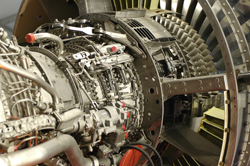Ensuring the stable operation of aircraft engines
Combustion instabilities are observed in numerous industrial systems, including direct injection aircraft engines. They are linked to undesirable flame extinction and flashback, as well as vibrations of the engine's mechanical structure, which can even lead to its destruction. Improved knowledge on heat and mass transfer phenomena within the combustion chamber is therefore of utmost importance for the formation of design methodologies that will minimise such instabilities. Extensive experimental and modelling work conducted within the MUSCLES project was dedicated to the evaporation of liquid fuel when injected directly into the combustion chamber. When heated in the combustion chamber, fuel droplets evaporate and finally the fuel vapour burns, delivering the essential energy for propulsion. The challenge was to develop and validate new theoretical models of fuel evaporation that would take into account the absorption of thermal radiation by the droplets. Researchers at the Instituto Superior Técnico in Portugal combined different optical techniques to measure the size, temperature and velocity of combusting droplets of liquid fuel under variable heat load conditions. The heat flux exchanged between the fuel droplets and the high temperature and high pressure environment within the combustion chamber could then be derived from their overall energy budget. Taking another step forward in this line of research, detailed knowledge of heat transfer by thermal radiation was used by the MUSCLES project partners to accurately determine the fuel evaporation rate. Thermal radiation regulates the temperature distribution and heat flux across the combustion chamber walls, the formation of soot and other products of incomplete combustion. Although ignored in most of the existing combustion models, the thermal radiation term can lead to significant improvements in their validity. In addition, by estimating the contribution of thermal radiation to fuel evaporation, the MUSCLES project has strengthened the current understanding of potential sources of combustion instabilities.







